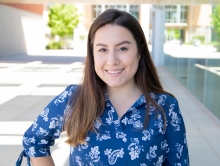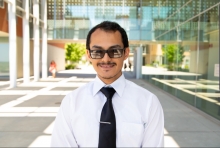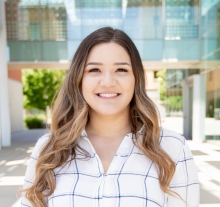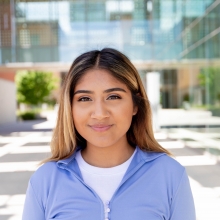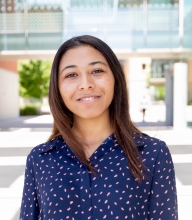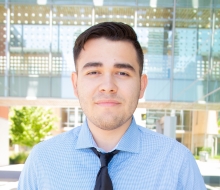Angelica Castillo
Angelica Castillo is an incoming third year undergraduate student from Santa Paula, CA. Angelica is expected to graduate from UC Merced in Spring 2021 with a BS in Biology with an emphasis in molecular and cell biology. At the beginning of her sophomore year, Angelica entered into Dr. Anna Beaudin’s lab and has loved helping with research experiments thus far. Angelica is a member of the sorority Delta Delta Delta and also holds a position of the member development chair. She is passionate about inspiring other young girls to pursue a career in STEM. When she isn’t in the lab or studying, Angelica loves to destress by watching movies, visiting her family, or going to Disneyland. In the future, Angelica aspires to get her PhD in immunology at a University of California.
Perturbation of Hematopoiesis in the Bone Marrow May Heighten Allergic Asthma Susceptibility
Angelica Castillo, Diego A. López, Anna E. Beaudin, PhD; School of Natural Sciences, University of California, Merced
In the United States, childhood asthma is the leading chronic disease affecting millions under the age of 18 and is responsible for the majority of childhood hospitalizations. Although the symptoms and progression of disease are relatively well characterized, our understanding of the mechanism that predisposes young children to a higher risk of developing asthma is still limited. Recently, type-2 innate lymphoid cells (ILC2s) have been shown to play a role in allergic asthma susceptibility. We hypothesize that immune activation during early fetal development may increase susceptibility to allergic asthma in offspring by altering the establishment of ILC2s and their progenitor cells, common helper innate lymphoid progenitors (ChILPs), in the neonatal bone marrow (BM). To evaluate this, we administered an intraperitoneal (IP) injection of viral mimetic poly (I:C) at embryonic day (E) 14.5. We then isolated the BM from postnatal day (P)14 offspring to identify whether there were differences in ILC2 and ChILP cell number & frequency. Our preliminary data demonstrates an increase in BM ChILPs of perturbed offspring compared to saline treated controls, which agrees with our previous ILC2 data in the lung. Overall, this suggests that early maternal perturbation can induce changes in hematopoiesis, including changes in BM ChILPs, which in turn may lead to overproduction of ILC2s in the lung and an increased risk for developing allergic asthma.
Jacob Espinosa
Jacob Espinosa is a third year undergraduate student from Elk Grove, CA. He is expected to graduate in Fall of 2021 with a BS in Bioengineering. He has increasingly become involved in the UC Merced community as Fundraising chairman of the American Red Cross club and Community Service co-chairman of Theta Tau, the Professional Engineering Fraternity. Jacob currently conducts stem cell research in Kara McCloskey’s lab. He is working to eventually earn a PhD in Bioengineering. Besides his work, Jacob enjoys reading, exercising, and watching television shows whenever he finds the time in his busy schedule.
Traction Forces Generated by Differentiating Endothelial and Smooth Muscle Cells
Jacob Espinosa, Jose Zamora, and Kara E. McCloskey, PhD; School of Engineering, University of California, Merced
It has long been known that stem cells will differentially differentiate in response to the mechanical stiffness of their substrates. It has been recently shown
that more vascular progenitor cells are directed into endothelial cells (ECs) on lower stiffnesses, while smooth muscle cells (SMCs) are generated on higher stiffnesses. One question that has not been addressed is the directionality of the traction forces produced by these differentiating stem cells. Using our two-step serum-free induction protocol, we have differentiated mouse embryonic stem cells (ESCs) on mechanically controlled polyacrylamide hydrogels (1kPa, 5kPa, 10kPa, and 40kPa) to examine their traction force speed and direction of movement. Based on literature, we expect that the ECs will exhibit non-directional radial traction forces, whereas SMCs will undergo polarized tractions. Primary ECs and SMCs will simultaneously be checked on these mechanically stiff hydrogels. This research has the potential to provide insight into how these cell types are able to co-differentiate and self-organize during early development.
Leslie Jimenez
Leslie Jimenez is a fifth year under graduate student from Whittier, CA. Leslie is expected to graduate in 2020 with an BS in Biological sciences emphasizing in human biology and minoring in psychology. After graduating from the University of California, Merced she aspires to continue her education in Graduate school hoping to help those in under served communities. Leslie as a part of UC Merced has been involved in ASUCM Campus Activities Board and has conducted research. Being an active member in her community she has volunteered her time at Mercy Medical Hospital, Kaiser Permanente, and UCSF Heal mobile clinic. To destress, Leslie finds herself playing volleyball, taking trips to rainbow pools and just enjoying time with her family.
Methods to Collect Preserve and Prepare Japanese Deep Sea Elasmobranch Liver and Muscle Tissue for Stable Isotope Analysis
Leslie Jimenez, Sora L. Kim, PhD; School of Natural Sciences, University of California, Merced
Through the method of stable isotope analysis one can gain insight on Japanese deep sea elasmobranch ecology. Tissue collection and preparation would allow for sampling in remote locations for stable isotope analysis. Due to the unique traits that the elasmobranch species acquire like retention of urea and lack of adipose tissue, further modified methods are needed for preparation techniques. Comparing collection, preservation, and preparation techniques helped identify that retention of urea and lipids that skewed isotopic data. Both elasmobranch muscle and liver tissue were collected and frozen. Lipids and urea were removed with petroleum ether, deionized water, and chloroform. The subsamples of the elasmobranch were dry frozen and the put into the EG in order to perform the stable isotope analysis. We expect to gather data on both carbon and nitrogen isotope values to determine the ecology in Japanese deep sea ocean.
Habibatu Mboka
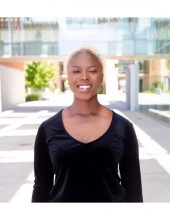 |
Major: Computer Science and Engineering
Home City: Turlock, CA
Contact: hmboka@ucmerced.edu
Faculty Mentor: YanQuan Chen
|
Habibatu Mboka is a rising third year undergraduate student from University of California—Merced. She plans to graduate with a Bachelor of Science in Computer Science and Engineering during the Spring of 2021. Alongside being a full-time student, Habibatu works as a Physics Instructional Lab Assistant by preparing the introductory physics course labs as well as advanced physics labs. One challenge that Habibatu has faced throughout her academic journey is her struggle to find a professional in her field of study who comes from the same background that she does—that is, a professional who is black and is also pursuing a career in Computer Science. This experience has inspired and challenged Habibatu to become a role model for future students. She also hopes that these students can see that despite her inability to find people like her in STEM, she overcame her feelings of otherness by embracing the facets of her identity that made her different. Despite the circumstances, she has continued to succeed and thrive in her current setting. Additionally, her long-term goal is to obtain a PhD in Computer Science and teach at the university level for students like herself. In order to achieve these goals, Habibatu strives to give her best effort in all aspects of her academic and personal life. As a testimony of her ability to work hard, she has been a recipient of the Calvin E. Bright Engineering Scholarship and Chancellor’s Scholar Award for two consecutive years.
Error and Interactive Segmentation Interfaces: A Step Towards Optimization
Habibatu K. Mboka, Guoxiang Zhang, MD, and YangQuan Chen, PhD; School of Engineering, University of California, Merced
Interactive segmentation tools are a key part of visual recognition, and one of the key ingredients to segmentation is rich datasets with ground truth labeled by human annotators. This ultimately allows for easier and faster data labeling. Recent work on interactive segmentation interfaces has used convolutional neural networks (CNNs) to greatly improve the accuracy or reduced number of clicks required; however, the performance accuracy of these networks is confounded by the variables which make up an image--such as resolution or background complexities--which cause an in increase in the total amount of clicks required. Our intuition is that by feeding images which contain variables such as these through an interactive segmentation interface, we can then find what variables cause the interface to fail, and ultimately get a better understanding of how to improve the accuracy and usability of interactive segmentation as a whole. To find the effect of these unknown variables, we create a dataset containing altered images of various resolutions, tints, and background complexities. We then feed these complex or altered images through the CNNs to calculate what cause such an increase for the total click amount. From this process, our results have shown that the networks often fail to segment objects in front of complex backgrounds and images that have poor resolution with less than five clicks.
Steven Ortiz-Donato
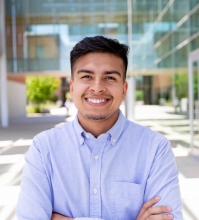 |
Major: Mechanical Engineering
Home City: Mid-City, Los Angeles, CA
Contact: sortiz28@ucmerced.edu
Faculty Mentor: Jian-Qiao Sun
|
Steven is an incoming 5th year mechanical engineering undergrad expected to graduate in Spring 2020. His career interests are in automotive engineering, specifically with alternative fuel vehicles. He has a strong belief in the improvement of sustainable energy methods because he loves the environment. He plans on entering the industry after he gets his Bachelor’s degree and hopes to get sponsored to attend graduate school in the future. Last summer he was a project engineer for Webcor, the general contractor spearheading the Merced 2020 project. It makes him proud to have contributed to the growth of his own campus and is excited to come back as an alumni. On campus he is the Fraternity and Sorority Life Intern and a Founding Father of the Kappa Mu chapter of Pi Kappa Phi at UC Merced where he currently serves as the President. For fun he likes to write and record his own indie music (edit: search "Sharms" anywhere), since he has been a musician since he was a child. He also enjoys reading philosophy and spending time with his friends and fraternity brothers.
Energy Harvesting of Highway Traffic Through Piezoelectricity
Steven Ortiz-Donato, Cheng Chen, and Jian-Qiao Sun, PhD; School of Engineering, University of California, Merced
Vehicle traffic on California highways can provide a significant source of electric energy by converting mechanical energy in the form of vibration of vehicles into electricity by piezoelectrics. This energy can be used to charge electric vehicles, illuminate highways, and feed the grid. Different from other projects of a similar focus, we designed a nonlinear mechanical structure that amplifies mechanical force by 10 times and used multilayer PZT (lead zirconate titanate, piezo ceramics) stacks for an exponential energy growth. In this project, we constructed 360 mechanical amplifiers which were stacked on top of each other in groups of three to make 120 power-generating towers. With an assumption that the average vehicle provides 120 psi of downward stress, our current design can reach up to 233.6 kWh/(m2.year) and this energy outcome will be greater with heavier vehicles. In comparison, mass-produced solar modules produce 216 kWh/(m2.year) on average in California. This energy harvesting method is advantageous because it can be integrated into the pavement, it works 24/7 under any weather condition, it has high potential with 164,000 miles of highways in the USA, and it requires low manufacturing costs compared to other clean energy sources. The next step in this research is to conduct tests to optimize parameters of the generator to improve outcome.
Breanna Paredes
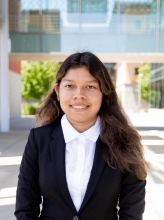 |
Major: Bioengineering
Home City: Roseville, CA
Contact: bparedes2@ucmerced.edu
Faculty Mentor: Anand Subramanian
|
Breanna Paredes is a fourth-year undergraduate student from Roseville, California. She expects to graduate in Fall 2020 with a Bachelor of Science in Bioengineering. Breanna is currently involved in the Theta Tau Professional Engineering Fraternity where she is the Risk Management Chairman. One of Breanna’s biggest accomplishments in her life was to obtain a third-degree black belt in nine martial art styles because it took her twelve years to earn this belt rank and demonstrated that she has the dedication, patience, perseverance, and courage to obtain this high achieving title. Some of Breanna’s goals after graduation are to obtain a PhD in Bioengineering, become a professor in a research university, and inspire women to pursue a career in STEM especially in engineering. To destress, she loves to go to the gym, play tennis, hang out with friends at local coffee shops, and go mall shopping.
Extracting Giant Unilamellar Vesicles from Cellulose Substrates by Vortex Mixing
Breanna Paredes, Vaishnavi Girish, and Anand B. Subramaniam, PhD; School of Engineering, University of California
The Paper-Abetted liPid hYdRation in aqUeous Solutions (PAPYRUS) method is a simple approach of growing giant unilamellar vesicles on cellulose based substrates. The current method uses a piece of paper 9.5 mm in diameter. Since the paper is relatively small, vesicles can be harvested by manually aspirating across the surface of the paper with a micropipette. Manual aspiration with a pipette over the surface of a larger sheet of paper however is challenging. This is a crucial limitation because if we wanted to encapsulate proteins or medicine for drug delivery usage, then it must be produced at a larger scale. We performed systematic experiments to determine if automated shaking using a vortex mixer of vesicle-covered papers in custom-made Polydimethylsiloxane (PDMS) chambers is a viable method for a larger scale harvesting of vesicles. We find that shaking solutions after vesicle growth results in similar vesicle sizes and quantities as the results of manual aspiration. Future work will be to reapply the shaking method onto a larger cellulose substrates in order to produce a large amount of vesicles.
Michelle Perez-Arreola
Michelle Perez-Arreola is an undergraduate student going into her third year at the University of California, Merced. Expected to graduate Spring 2021 with a BS in Biology with an emphasis in Molecular and Cell Biology, Michelle has been an active student at UC Merced through conducting research during her second year in the Ge lab, a member of DEM, and a lab assistant in the Instructional Biology Labs. Michelle thinks it is important to find joy in what you are doing and hopes to break the boring lab stigma. To destress, Michelle enjoys the beach and running. Her ultimate goal is to obtain a PhD in cellular biology and be an inspiration to her siblings.
Detecting LEAP2 Levels in GHSR Knockout Rat
Michelle Perez-Arreola, Hualing Peng, Xuecai Ge, PhD; School of Natural Sciences, University of California, Merced
GHSR (growth hormone secretagogue receptor) is the receptor for ghrelin ,an appetite-stimulatory hormone that is secreted by the stomach. The GHSR-ghrelin signal is involved in multiple metabolic processes, including food intake, and protection of animals from starvation-induced hypoglycemia. Our previous studies discovered liver-expressed antimicrobial peptide 2 (LEAP2) as an endogenous antagonist for GHSR. LEAP2 is produced in the liver and small intestine. LEAP2 inhibits GHSR activation and blocks Ghrelin’s effect in vivo. Therefore, understanding how LEAP2 expression is regulated in vivo will provide valuable insights in the control of GHSR-ghrelin signaling. In collaboration with the Leggio’s group at NIAAA, we detected the expression levels of LEAP2 in multiple tissues in GHSR knockout rats. We found LEAP2 expression levels varies significantly between different tissues and between different genotypes in rats. Our results may help deepen our understanding between LEAP2 expression and the GHSR-ghrelin signaling.
Diana Ramos
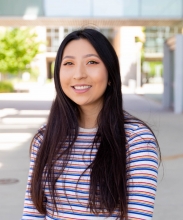 |
Major: Biological Sciences
Home City: San Diego, CA
Contact: dramos37@ucmerced.edu
Faculty Mentor: Aaron Hernday
|
Diana Ramos is a fourth-year undergraduate student from sunny San Diego, CA. Expected to graduate Spring of 2020 with a BS in Biology she lead’s the path for her siblings as she is a first-generation college student. She continues to conduct research in the Hernday Lab, further researching Candida albicans and CRISPR using cas 9. Diana also takes part being an intern at the primary care research institute helping eliminate health disparities in the Central Valley by tackling common issues like physician shortages and creating new and more efficient systems including implementing technology-based solutions. She is a member of UC Merced’s pre-pharmacy club, as well as an active volunteer of UC Merced blood drive. To keep herself sane Diana finds herself at music festivals, concerts, and sunbathing at beach. Her main goal is to receive a PhD in Immunology and be the successful women she always dreamed of as a kid.
Utilizing CRISPR-Cas9 to Validate Gene Addbacks to their Native Locus in Candida albicans
Diana Ramos, Namkha Nguyen, Aaron D. Hernday, PhD; School of Natural Sciences, University of California, Merced
Candida albicans is the most common opportunistic human fungal pathogen and is associated with mortality rates in excess of 50%. Recent development of precision genome editing techniques have accelerated the pace of molecular genetic studies of this pathogen, allowing researchers to quickly and easily edit virtually any location in the C. albicans genome. A common application is to generate homozygous deletions of a gene of interest, however, methods for restoring a knocked-out gene to its native locus – an important experimental control – require improvement. The Hernday lab demonstrated a proof-of-concept technique using “Add-tags”, which are unique target sites that can be integrated into the locus where a gene was knockout, these “landing pads” can be used for re-integration of the native gene at the native locus. We will be validating and optimizing this proof-of-concept approach by using our CRISPR-mediated genome editing system to delete and replace several genes with Add-tags and then restoring their native gene. Then we will test if the original phenotype is better restored than previous addback methods which rely on single-copy genes added at a non-native locus. Not only does this Add-tag approach serve as an important experimental control but can help demonstrate the ability to perform precise edits at the native loci that are not directly targetable by CRISPR.
Adrian Sanchez Magana
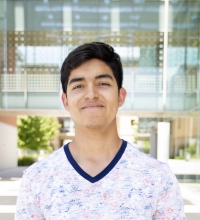 |
Major: Computer Science and Engineering & Physics
Home City: Heber, CA
Contact: asanchez298@ucmerced.edu
Faculty Mentor: Jay E. Sharping
|
Adrian Sanchez Magana is a passionate Junior standing undergraduate student from UC Merced expected to graduate in Spring 2022 and seeks for a Ph.D. in Physics. His passion for discovery is what keeps him thinking and learning. Adrian is originally from Mexicali Baja California, Mexico and from a young age he discovered the dangers of crime which resulted in his family immigrated to The United States of America. From the struggles of being an English Learner to a successful undergraduate, Adrian has shown that every task he faces is possible if he sets his mentality. As the project chair of Ingenieros Unidos (SHPE Chapter of UC Merced), he seeks to shape every contributor to this organization into becoming a researcher. Adrian hopes to be a role model to not just his community but worldwide to persuade those with similar backgrounds to seek higher education.
Conservation of Momentum in Second-Harmonic Generation
Adrian Sanchez Magana, Jonathan Daniel, and Jay E. Sharping, PhD; School of Natural Sciences, University of California, Merced
Second-harmonic generation occurs when photons interact within a nonlinear crystal that allows photon frequency conversion. This phenomenon occurs when multiple photons enter a virtual state, an unobservable quantum state, and due to energy conservation laws, a new photon is generated with equal energy from the photons in the virtual state. The purpose of this investigation is to deduce if the second-harmonic generation also follows the conservation of momentum law. Utilizing an infrared 1064nm pulsed LYNX laser and a nonlinear Barium Borate crystal, the pulsed beam was split into a “pump” and “escort” beam and aimed at different angles into the crystal. By varying the intensities, angle of incidence, and polarization of both beams then the intensity of the generated 532nm will show dependency. If momentum conservation laws apply, then a 532nm beam should be seen between the two noninteracting 1064nm beams. It is expected that the conservation of momentum applies due to the wave-particle property of light and could lead to improved quantum information sources without cryogenic systems.
Pedro Torres
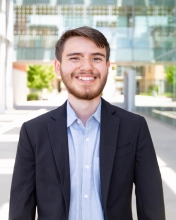 |
Major: Computer Science and Engineering
Home City: Bakersfield, CA
Contact: ptorres29@ucmerced.edu
Faculty Mentor: YanQuan Chen
|
Pedro Torres is a rising 3rd year undergraduate student from UC Merced. Expected to graduate in Spring 2021 with a Bachelor of Science in Computer Science and Engineering. Pedro has been an active member on his campus by participating in research and in several organizations on campus to further his professional development and extend his involvement within the community. As an Active member of The Society of Professional Hispanic Engineers he participated in career development and student success workshops and attending Hackathons that were two-day events to create an application. Pedro participated in Facebook’s Data Challenge 2019 - West Coast to analyze data in the San Francisco area and create a business idea that will utilize Facebook’s technology and services. Being in the Society of Professional Hispanic Engineers has helped him develop as a leader and to become a role model for incoming undergraduate students. To relax, Pedro finds video games and Netflix as the best activities. After completing his bachelor’s degree Pedro hopes to pursue a master’s degree in computer science. The long-term goal for Pedro is to have a position at Facebook for Data Engineering.
Object Detection from Point Clouds: Optimize Raw Data Loading and Preprocessing
Pedro J. Torres, Guoxiang Zhang, MD, YangQuan Chen, PhD; School of Engineering, University of California, Merced
An ongoing issue with Computer visualization is capturing patterns in data sets due to the lack of the complexity of an object and variety input point sets. Due to distance and image detail being a form of error in image visualization, solution would be implementing Hierarchical point set feature for learning Sample layer, Grouping layer, and PointNet Layers for higher detail in objects. The algorithm will gather set points from a data set, each group will correlate to a local region and form “K” the number of points in a grouped portion of an image a neighborhood. In PointNet Layering is getting a local region of points and withdraw them from its neighborhood where it may not belong and capture similar oddities to form its own local region. This form of camping layers in neighborhoods is more valuable compared with a Euclidean neighborhood which could include points in distant surfaces. In Higher dimensional metric spaces where Convolutional Neural Networks method is not possible while the Hierarchical point set feature is scaling diverse data sets well and efficiently.
Christina Valletta
Christina Valletta is going in to her third year of undergraduate studies at UC Merced, with the ultimate goal of obtaining a PhD in physics. She is faithfully in good academic standing and is expected to graduate on time with the class of 2021. Christina highly values education and thinks it is important to learn throughout life. Apart from academics, she also participates in research as she has been part of the Sharping research group since spring semester 2018. The Sharping group is a university affiliated optics group, which more recently has been dabbling in macro-quantum cavities. Her work with cavities exposed her to dilution refrigerators, working under vacuum and making coupling antennas. Eventually, she hopes to explore theoretical research and work for a small research facility.
The Development of a Quantum-Optical Apparatus used in the Evaluation of Photon Statistics
Christina Valletta, Jonathan Daniel, Jay Sharping, PhD; School of Natural Sciences, University of California, Merced
One of the most interesting and principle pieces to quantum optics is photon statistics; more descriptively, the optical setup used to measure photon statistics. Here, an optical setup for observing the second order correlation coefficient was developed. Using a Hanbury-Brown Twiss interferometer and photon counters, the second order correlation coefficient for a laser system measured. One would expect coherent light, in other words a g2 close to one. This setup will show that laser light is coherent and lead the way for other quantum optic experiments.
Joseline Velasquez
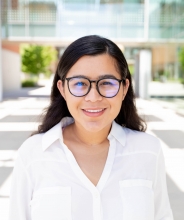 |
Major: Human Biology & Psychology
Home City: Los Angeles, CA
Contact: jvelasquez24@ucmerced.edu
Faculty Mentor: Emily Jane McTash
|
Joseline Velasquez is a fifth-year undergraduate student from Los Angeles, CA. Expected to graduate Spring 2020 with a BS in Biology with a human emphasis as well as a BA in Psychology. Joseline is part of the Bright Success Center serving as a Success Mentor and Student Coordinator. From her experience of mentoring first year students, she understands the importance of providing students with access to all the resources early in order to create the best experience at University of California, Merced. On her free time, Joseline goes to different cities in California for concerts or just to explore what they have to offer. She aspires to complete a biological psychology PhD program. However, she really just wants to be an example for her community back home to encourage others to also pursue higher education.
Identifying Inheritance Patterns in African Cattle
Joseline M. Velasquez-Reyes, Emily J. McTavish, PhD; School of Natural Sciences, University of California, Merced
Andie Venegas
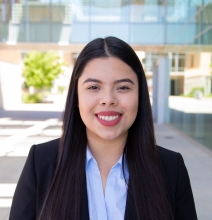 |
Major: Molecular and Cell Biology
Home City: Los Angeles, CA
Contact: avenegas25@ucmerced.edu
Faculty Mentor: Nestor Oviedo
|
Andie Venegas is a rising third year from Los Angeles, CA. She is expected to graduate in Spring 2021 with a Bachelor of Science in Molecular and Cell Biology. Andie is focused on challenging herself, excelling in her academics, and becoming involved in extracurricular activities during her time as an undergraduate student. After graduating, Andie seeks to obtain a PhD in Molecular and Cell Biology and contribute new findings and research to the field of Cancer Biology. This summer, Andie will be working in Professor Oviedo’s lab where she will study tissue regeneration, tissue maintenance, and cancer using planarians due to their stem cells, evolutionary conservative cellular signaling pathways, and regenerative properties. Ultimately, she is passionate about being a female role model as a woman in STEM to minorities and young women in order to help them pursue higher education and careers in STEM fields. During her free time Andie likes to spend time with friends and go to amusement parks.
Application of Electric Stimulation in Damaged Tissues Enhances Stem Cell Repopulation in Planarians
Andie Venegas, Peter Karabinis, and Nestor J. Oviedo, PhD; School of Natural Sciences, University of California, Merced
Electrical stimulation can enhance tissue repair when applied locally to a tissue. However, the underlying mechanism is not fully understood. The Oviedo lab has developed a strategy using the planarian model organism, Schmidtea Mediterranea, for applying steady-state Direct Electrical Stimulation to a whole system (pDCS) and tracking the effects on the stem cell populations. Planarians contain stem cells, called neoblasts, that regenerate every tissue in the body. -irradiation is a fatal form of ionizing radiation that eliminates neoblasts, and regenerative properties in a system. Our approach uses pDCS applied to irradiated and control animals and immunohistochemical analyses to track neoblast markers and mitotic activity. We are able to identify intrinsic and extrinsic factors affected from pDCS using an approach that engrafts tissues containing neoblasts to lethally irradiated tissues. Upon application of pDCS we see that neoblast markers and mitotic activity are restored in lethally irradiated tissue that has been transplanted with stem-cell tissue. In the control group, neoblast markers and mitotic activity is only restored in the area surrounding the transplanted tissue. Our data suggest that pDCS enhances stem cell repopulation in lethally irradiated tissue by restoring transcriptional activity and cell cycle entry. This method of restoring stem cell repopulation in irradiated tissue can help the understanding of enhanced tissue regeneration and repair upon the application of localized electrical stimulation.
Gabriel Viramontes
Gabriel Viramontes will be a third-year student this coming fall. He is expected to graduate Spring of 2020, as he was placed in a dual enrollment program during high school he thus came to UC Merced with 2 years under his belt. He will be conducting research in Clarissa Nobile’s lab investigating how the deactivation of certain transcription factors can affect antifungal resistance mechanisms. On his spare time, Gabriel enjoys writing and hearing music. With his favorite song “People Like Us” by Kelly Clarkson, connecting on a personal level do to his LGBTQ+ orientation. With a year left, Gabriel has his mind set on attending graduate school and achieving his Ph.D. in Zoology.
Identification of Transcription Factors Regulating Caspofungin Induced Flocculation
Gabriel A. Viramontes, Craig L. Ennis, and Carissa J. Nobile, PhD; School of Natural Sciences, University of California, Merced
Candida albicans is aa resident of the human microbiota. Changes in the host’s immune system, pH, and gut flora can lead to life-threatening disseminated infections. Caspofungin acetate is a commonly prescribed antifungal agent for treatment of disseminated Candida infections that inhibits the production of Beta-(1,3)-D-glucan, promoting a lack of fungal cell wall production. Interestingly, C. albicans yeast cells will flocculate, tightly adhering to one another, in response to Caspofungin treatment. We hypothesize that flocculation is a response that allows C. albicans to increase resistance and survival to Caspofungin, and this phenomenon is regulated by several transcription factors. We utilized a forward genetic to screen a homozygous transcription factor deletion mutant library, to identify transcription factors with altered abilities to flocculate. Thus far, we have identified that deletion of transcription factors EFG1, FLO8, CAS5, and ACE2, resulting in reduced or increased clumping after exposure to the antifungal drug. Deletion of CAS5 triggered cells to overclumping, which is contradictory to this gene main function of adherence. Understanding the regulation of this drug response will provide insight on the response to Caspofungin at a molecular level, which lead to the development of additional therapeutic solutions.
